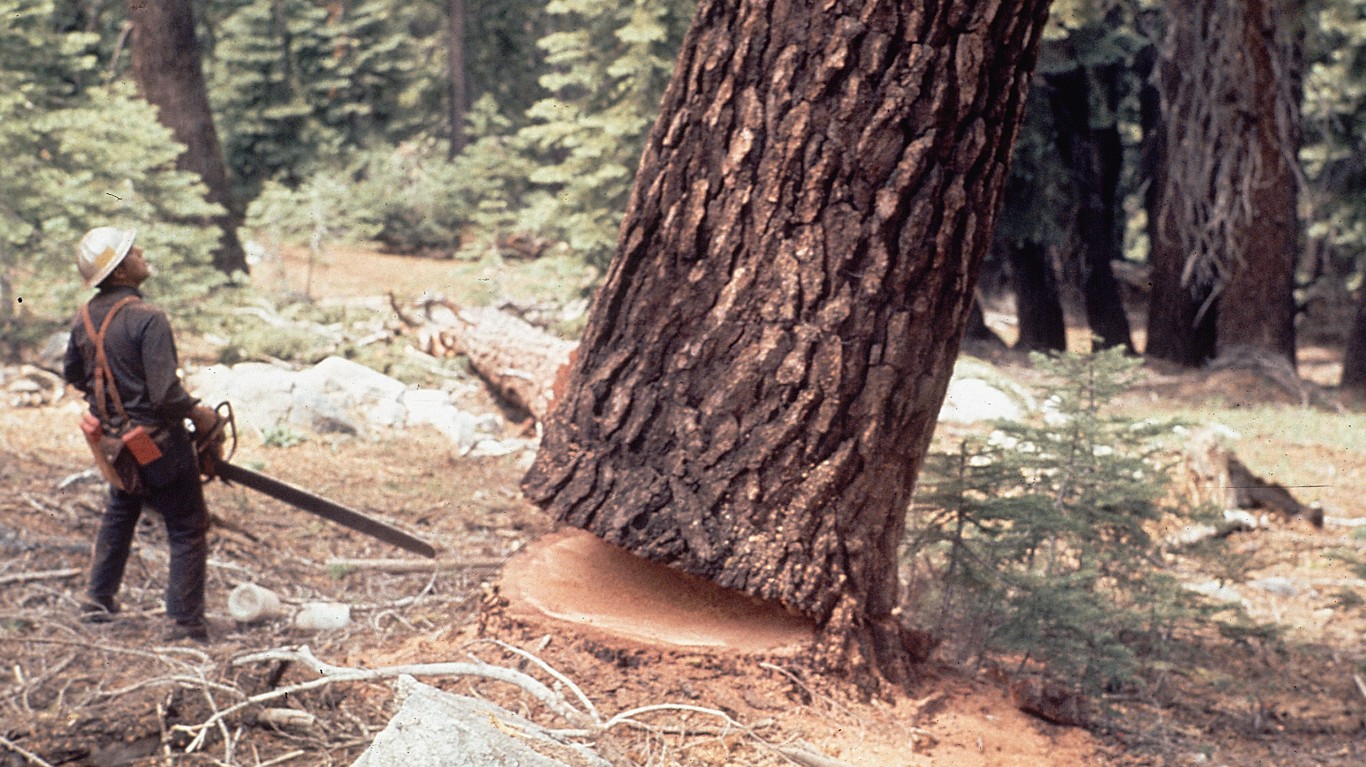
An employee’s job satisfaction largely depends on their particular employer. But in some careers, dangerous tasks, high levels of stress, and public scrutiny are all commonplace and can take a toll on employee satisfaction, no matter who the boss is.
24/7 Wall St. reviewed the 2018 Jobs Rated Report from CareerCast, a targeted job opportunity website, to determine the worst jobs in America. The report ranks over 200 careers on the overall quality of their work environment, amount of stress, occupational outlook, and income.
Many of the worst jobs in America rank poorly because they have among the least job security in the U.S. labor force. The rise of automation could reduce or completely eliminate certain unskilled professions as well as some of the most dangerous jobs in the country.
Of the 30 worst jobs in America, the median annual wage of 23 is less than $50,000 a year. While people in many parts of the country can live comfortably on this income, some of these professions — like taxi drivers, reporters, broadcasters, and more — are based in major cities, where the cost of living tends to be higher.
All jobs come with at least some kind of stress, like public scrutiny and the pressure to succeed. In the worst jobs, these stresses are often more acute — such as the physical danger firefighters and members of the military face, or the stress of dealing with angry customers of workers in retail and the food service industry.
Click here to see the worst jobs in America
Methodology
To determine the worst jobs in America, 24/7 Wall St. reviewed the 2018 Jobs Rated Report from jobs website CareerCast. We supplemented the CareerCast ranking with data from the U.S. Bureau of Labor Statistics. Data on median annual wages for may 2018 and total employment came from the BLS Occupational Employment Statistics program. Projected job growth rates from 2016-2026 also came from the BLS.

25. Photographer
> Median annual wages: $34,000
> Projected job growth, 2016-2026: -5.6%
> Total employment: 49,560
Photographers earn a median wage of $34,000 per year, slightly below the median wage for all U.S. jobs of $37,690. The average U.S. job is projected to have employment growth of 7% from 2016 to 2026, but photographers employment is projected to decline more than 5% in that same time frame. Thanks to camera-equipped smartphones some aspects of photography are more accessible for nonprofessionals. Other photography jobs could be eliminated as companies choose to hire freelancers rather than keeping salaried photographers on their payrolls.
[in-text-ad]

24. Food server
> Median annual wages: $23,290
> Projected job growth, 2016-2026: +10.2%
> Total employment: 266,190
Food service is a difficult job, requiring servers to spend hours on their feet and interact with many customers in the space of one shift. Servers also depend on tips from customers, as opposed to earning a standard wage or salary like most other jobs. This is one reason servers have one of the lowest median annual wages at $23,290.

23. Roofer
> Median annual wages: $39,970
> Projected job growth, 2016-2026: +11.1%
> Total employment: 128,680
Roofers install, repair, and replace roofs. They have a difficult working environment. Unable to work in bad weather, roofers often have to work all day in the summer, contending with heat and the relatively dangerous conditions of working on sloped, elevated surfaces. Despite these conditions, most roofers earn less than $40,000 per year, in part because it is an unskilled occupation that does not require a specific level of education.

22. Welder
> Median annual wages: $41,380
> Projected job growth, 2016-2026: +5.6%
> Total employment: 389,190
Welding is often a physically demanding job because welders often have to work in awkward positions and lift heavy metal objects. This makes for a challenging — and potentially dangerous — work environment. As U.S. infrastructure continues to age, welding jobs should grow steadily nationwide to repair and rebuild structures like bridges, buildings, and roads.
[in-text-ad-2]

21. Water transportation worker
> Median annual wages: $54,400
> Projected job growth, 2016-2026: +7.6%
> Total employment: 79,860
Water transportation workers are in charge of directing and maintaining the ships and boats used to move people and cargo across rivers, lakes, oceans, and other waterways. Piloting a boat of any size requires at least some expertise and experience. Any mistake or mechanical failure can be disastrous and even fatal, making this a stressful career. Most water transportation workers make over $54,000, well above the median income for all American jobs.

20. Brickmason
> Median annual wages: $50,950
> Projected job growth, 2016-2026: +10.3%
> Total employment: 63,930
Brick masonry is a physically demanding job, as workers have to lift, move, and lay heavy materials — typically outdoors and often during the summer. These workers also face demands to complete projects on time and under budget, adding to the stress of the position. Brick masonry does have several upsides, including the relatively high median annual wage as compared to the median of all jobs and the fact that the growing U.S. population will likely lead to steady job growth in the industry.
[in-text-ad]

19. Automobile mechanic
> Median annual wages: $40,710
> Projected job growth, 2016-2026: +6.1%
> Total employment: 648,050
Though working as an automobile mechanic requires some postsecondary education, specifically at a trade school, as well as a certification, the median annual pay of mechanics is just slightly higher than that of the average American job. Mechanics often have a difficult job environment as they regularly get into awkward and uncomfortable positions for long stretches to diagnose and fix automotive problems.

18. Buyer
> Median annual wages: $62,750
> Projected job growth, 2016-2026: -5.6%
> Total employment: 407,410
Though a buyer is a vague job title and buyers work in many different fields, they most commonly work on behalf of grocers and other wholesalers, buying produce for resale at stores. Though buyers are well compensated, earning a median annual wage of $62,750, the career field is projected to shrink and lose workers by 2026. According to the BLS, “outsourcing and automation of less complex procurement functions” will lead to a decline in this job’s outlook.

17. Truck driver
> Median annual wages: $43,680
> Projected job growth, 2016-2026: +5.8%
> Total employment: 1,800,330
Though the projected job growth for truck drivers is only slightly lower than for the average American job, this career could be at risk of disappearing as companies like Tesla continue to develop autonomous driving technology. Driving a truck can be a difficult and stressful job. Drivers are responsible for vehicles that often weigh over 26,000 pounds and often lose sleep to meet strict delivery deadlines.
[in-text-ad-2]

16. Construction laborer
> Median annual wages: $35,800
> Projected job growth, 2016-2026: +12.4%
> Total employment: 1,001,470
Construction workers are employed in one of the fastest growing industries in the country. As the American population continues to grow, more and more laborers will be needed to build the growing demand for offices and homes. Workers in this unskilled position are not well compensated, typically earning less than the median of most jobs. Construction laborer is one of the most physically demanding jobs in America as well as one of the most dangerous — the job has one of the highest illness and injury rates among all occupations.

15. Dockworker
> Median annual wages: $28,260
> Projected job growth, 2016-2026: +7.6%
> Total employment: 2,893,180
Dockworkers, also known as longshoremen, are some of the least well compensated workers in the country, with a median annual wage nearly $10,000 less than the typical U.S. job. The job requires hours of strenuous physical labor as workers work to load and unload ship cargo. This type of work, with heavy boxes and pallets, can also be dangerous and lead to injuries.
[in-text-ad]

14. Bus driver
> Median annual wages: $42,080
> Projected job growth, 2016-2026: +9.0%
> Total employment: 174,110
Bad weather, heavy traffic, and unruly passengers are among the many stressors bus drivers face while on the job. Though bus drivers are typically required to obtain a commercial driver’s license before they can start working, they are not especially well compensated. The profession’s median annual wage is about $42,000, as compared to the median American annual wage of $37,690

13. Chef
> Median annual wages: $48,460
> Projected job growth, 2016-2026: +9.6%
> Total employment: 128,600
Chefs work a difficult and demanding job. As the head of the kitchen, they oversee all food preparation at restaurants and other establishments. The job can be stressful as chefs must ensure all food is prepared correctly, quickly, and to the customers’ specifications. Chefs often work a non-traditional schedule, including late nights, weekends, and holidays. These shifts require chefs to spend hours on their feet.

12. Firefighter
> Median annual wages: $49,620
> Projected job growth, 2016-2026: +7.2%
> Total employment: 321,570
Fighting fires is one of the most difficult and dangerous jobs in America. These emergency workers must often face dangerous infernos — either in a manmade structure or in the wild as wildfires are becoming more frequent. Beyond the stress and danger of rushing into life threatening situations, firefighters also have a schedule that can be taxing. They must be on call for shifts that typically last about 24 hours, eating and sleeping at the fire station.
[in-text-ad-2]

11. Pest control worker
> Median annual wages: $35,610
> Projected job growth, 2016-2026: +8.2%
> Total employment: 77,300
There are many unpleasant aspects of being a pest control worker. Beyond dealing with roaches, rats, termites, and more, pest control workers must often bend and crawl their way into tight spaces to search for and eliminate pests. Many of these workers also must use pesticides, which are toxic and can be extremely harmful if not handled properly. Pest control work is one of the lower paid jobs in the country, with a median annual wage of $35,610 — about $2,000 less than the median American job.

10. Painter
> Median annual wages: $38,940
> Projected job growth, 2016-2026: +5.7%
> Total employment: 228,420
Painting can be a physically demanding job as it requires painters to crouch, reach, and kneel to reach all areas that need to be painted. Some painters who work on bridges or tall buildings may have to be comfortable with working high up in the air. Most painters make less than $40,000 per year.
[in-text-ad]

9. Advertising salesperson
> Median annual wages: $51,740
> Projected job growth, 2016-2026: -3.6%
> Total employment: 133,110
While the average job is projected to grow about 7% from 2016 to 2026, the number of advertising salespeople in the U.S. labor force is projected to decline during that period. Many workers in this profession sell space in print media outlets, like newspapers and magazines. But as these outlets decline in circulation or go out of business, fewer advertising sales agents will be needed. Workers in the industry face significant pressure to meet their sales quotas.

8. Broadcaster
> Median annual wages: $40,080
> Projected job growth, 2016-2026: -3.2%
> Total employment: 31,580
The BLS projects there will be 3.2% fewer broadcasters in the U.S. labor force in 2026 than there were in 2016. As ad revenue decreases for radio and television broadcasts, stations will likely not be able to afford to employ as many broadcasters as they once did. Though a bachelor’s degree is typically the minimum requirement for this job, the median annual wage is just slightly higher than the U.S. median wage for all jobs of $37,690.

7. Disc jockey
> Median annual wages: $33,220
> Projected job growth, 2016-2026: -11.6%
> Total employment: 27,780
Though it may seem like a great job, disc jockeys, or DJs, are projected to face one of the most challenging working environments in the future. With the rise of online music streaming and podcasts, listeners have other music options than listening to radio stations. This is partially to blame for the projected 11.6% decline in DJ jobs. Those DJs who have a job are typically not well compensated as most make less than $34,000 per year.
[in-text-ad-2]

6. Corrections officer
> Median annual wages: $44,330
> Projected job growth, 2016-2026: -7.7%
> Total employment: 415,000
At the end of 2016, the most recent year with available data, there were just over 1.5 million prisoners in the United States, down from the peak of 1.6 million in 2009. This decline in the prison population, as well as budgetary issues, will likely contribute to the expected 7.7% drop in the number of working corrections officers in the United States. Largely as a result of violent inmates, corrections officers have among the highest injury and illness rates of all jobs.

5. Enlisted military personnel
> Median annual wages: N/A
> Projected job growth, 2016-2026: N/A
> Total employment: N/A
Serving in the U.S. military differs from most jobs on this list as military personnel choose to serve their country. It may therefore seem unfair to list them among the “worst” jobs, yet they do face very high stress and one of the most difficult working environments possible — especially those serving in combat zones. Meanwhile, many often earn less than $30,000 a year.
[in-text-ad]

4. Retail salesperson
> Median annual wages: $24,200
> Projected job growth, 2016-2026: +1.7%
> Total employment: 4,448,120
As a customer-facing job, retail sales workers have a relatively challenging work environment. The job is also one of the lowest paid jobs in the country, with a median annual income of $24,200 — well below the U.S. median of $37,690. The job market for the position is projected to grow at less than 2% by 2026, well below the growth for the average job. The continued rise of online shopping and the struggles of brick-and-mortar retailers may have an even greater impact than anticipated on the number of retail workers.

3. Newspaper reporter
> Median annual wages: $41,260
> Projected job growth, 2016-2026: -10.0%
> Total employment: 37,140
The number of newspaper reporters is projected to drop 10% by 2026 as newspapers lose readers and ad revenue. Reporters often face intense scrutiny from readers, added to the stress of print deadlines. In an increasingly polarized political environment, reporters are often inundated with negative feedback from readers and even some death threats.

2. Logger
> Median annual wages: $40,650
> Projected job growth, 2016-2026: -12.6%
> Total employment: 37,400
Logging ranks as the second worst job in America, in large part because it also ranks as the second most dangerous job. There were 55 fatal injuries and 350 nonfatal injuries among loggers in 2017. Since it is such a dangerous job, many companies are looking into automating the process of felling trees by hand. This may explain the projected 12.6% decrease in logging jobs by 2026. Even when done safely, logging is very physically strenuous and does not pay especially high wages.
[in-text-ad-2]

1. Taxi driver
> Median annual wages: $25,980
> Projected job growth, 2016-2026: +5.0%
> Total employment: 207,920
The combination of low pay, slow employment growth, high stress, and an undesirable work environment has made taxi driving the worst job in America. Taxi drivers work all hours of the day, sometimes in inclement weather, dealing with traffic jams and potentially unruly or rude passengers. Most taxi drivers earn less than $26,000 per year, as compared to the median American annual wage of $37,690. Though the number of taxi drivers is projected to increase by about 5% by 2026, this growth may be curtailed by the rise of ride hailing companies like Uber and Lyft.
Want to Retire Early? Start Here (Sponsor)
Want retirement to come a few years earlier than you’d planned? Or are you ready to retire now, but want an extra set of eyes on your finances?
Now you can speak with up to 3 financial experts in your area for FREE. By simply clicking here you can begin to match with financial professionals who can help you build your plan to retire early. And the best part? The first conversation with them is free.
Click here to match with up to 3 financial pros who would be excited to help you make financial decisions.
Thank you for reading! Have some feedback for us?
Contact the 24/7 Wall St. editorial team.
 24/7 Wall St.
24/7 Wall St. 24/7 Wall St.
24/7 Wall St. 24/7 Wall St.
24/7 Wall St. 24/7 Wall St.
24/7 Wall St.

